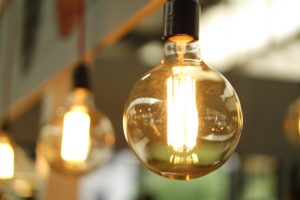
The race to zero carbon is on, with an ambitious target of 2050 for the United Kingdom. We all have a part to play in getting there, of course, but some can make a bigger contribution than others.
Lighting accounts for around 40% of the energy consumed by a modern building. As such, lighting presents a significant opportunity for businesses to reduce their carbon output and, importantly, save money on energy consumption at the same time.

A 10-15-year-old system consumes five times as much energy as a new one. 95% of the environmental impact caused by lighting comes from energy consumption, which can be reduced by up to 80% over its lifespan with modern LED luminaires and control systems.
Up to 80%? Yes, the rapid advancement of LED light sources in modern lighting products manufactured today are so much more efficient than they used to be. It is now possible to achieve up to 200 lumens per watt at source and, correctly used, with modern optical materials you can still deliver impressive energy and carbon savings. Adding to the savings for users, LEDs also last up to 10 times longer.
But, sadly for most commercial lighting installations, the solution to the issues we currently face is not as easy as just changing a traditional lamp.
It’s no longer just about the efficiency of the products we use. Lighting specialists like Phi need to go further and deeper than that, examining the efficiency of our supply chain and the production techniques and sustainability of all our materials and components to establish a whole-life cost of ownership.
It’s time to balance the performance of our lighting products with the initial outlay of installing solutions that have high energy levels in their production or within the supply chain. It seems likely that this cradle-to-cradle approach to costs will be the main guiding factor for future specification decisions as the focus on reduced carbonisation intensifies.

New Government legislation is demanding greater effort and application across the board, driving us in the direction of greater sustainability. There is already a range of regulations and best practice guidance in place for companies to follow. These include Part L, EPC, ETL, BREEAM and CIBSE/SLL.
So, how is efficiency measured? BREEAM (Building Research Establishment’s Environmental Assessment Method), the world’s leading sustainability method for planning projects, infrastructure and building, uses Watts per metre², together with many other metrics which get fed into building-wide calculations to establish the efficiency performance and assess the certification of the building.
Lighting has a significant impact on this graded certification, which can significantly help with the marketing of commercial space. It is essential that we take advantage of every benefit that modern technology and design can bring to efficiently meet the demands created by developers and building owners wishing to reduce energy usage and carbon impact.
In terms of design, we are seeing a change in working practices, partly due to the new ways we communicate and also driven by unique circumstances like Covid.
Increasing collaborative practices and hybrid working mean that workers visit the office less frequently, When they do, it’s not to work on computers at a fixed location, but rather to interact with colleagues face-to-face in more flexible spaces.
The lighting design requirement for this way of working is very different than the open plan, regular array of 600×600 luminaires we have seen in Cat A space for so long. It is now preferable to have pockets of light for meeting spaces linked with simple access and egress lighting.
It’s no longer necessary to have high light levels everywhere, but only to have them where required with lower levels linking them. This, in turn, creates more intimate spaces and adds a level of interest as low light areas frame pockets of light. A happy consequence of this technique is a lower power density and reduced energy consumption.

Phi’s ‘Momentum’ linear extruded system has a strong story to tell in terms of efficiency and modularity. This advanced solution is highly adaptable to project requirements, while significantly exceeding current performance guidance.
Available as individual or continuous systems, linear lighting is not a new concept and has been used successfully for many years. Our experience has always enabled us to match the right system to the project requirement.

Always ready to embrace positive change, Phi’s vision for a sustainable future covers three main areas.
We will continue to work closely with architects and client design teams to maximise the use of daylight in designs, wherever possible.
We will also take advantage of new smart fittings incorporating the Internet of Things. These enable data collection and the development of data-led services that ensure installations run as efficiently as possible. We support greater collaboration between the lighting controls industry and luminaire manufacturers to ensure seamless communication between the control services and luminaires.
Finally, we are committing to undertaking wider research into new manufacturing techniques and processes. These continue to evolve and we are always looking for opportunities to increase the use of recycled material in our product design and development.
If you would like to find out more about our efficient and sustainable lighting solutions, please get in touch with one of our friendly experts today.
I can rely on Phi being proactive on issues arising.
Relationships & Empathy
Phi understands us, our scope and our limitations.
Relationships & Empathy
Phi delivers a good solution, which is more than just a product. Their service is good, they talk through schemes with us and there is more to it than just a catalogue.
Technical Skills
The main asset of Phi is people and the high level of technical backup they provide. For example with their competitors I meet a salesman and not a technical salesman. This difference is crucial.
Technical Skills
Good quality products at a reasonable price.
Price
Phi is not the cheapest supplier but they offer quality architectural fittings.
Price
Phi’s personal service is appreciated and differentiates them.
Service
During completed projects, we have been happy with the performance and communication from Phi. I can rely on Phi being proactive on issues arising.
Service
I see Phi for architectural led office foyers, reception areas, bespoke spaces in office blocks and good architectural lighting for commercial developments
Spaces
Appropriate for the commercial sector in particular and other places where there is a modern style requirement as befits their current product range.
Spaces
Phi is most suited to commercial offices, associated rooms and educational buildings.
Spaces
Phi delivers a good solution, which is more than just a product.
Perception & Image
We are project focused; there are lots of people in the industry but it is questionable whether they want to help and support properly. Why change to someone who may let you down, you stick with the best.
Perception & Image
Phi is not mainstream but a specialist niche architectural supplier who is a little bit different.
Perception & Image
Phi offer support, which sets them apart.
Perception & Image
Phi is a strong quality architectural supplier, giving good advice where we are lacking.
Perception & Image
Phi offer a great level of experience, supply, service and back up.
Perception & Image
I can rely on Phi being proactive on issues arising.
Relationships & Empathy
Phi understands us, our scope and our limitations.
Relationships & Empathy
Phi delivers a good solution, which is more than just a product. Their service is good, they talk through schemes with us and there is more to it than just a catalogue.
Technical Skills
The main asset of Phi is people and the high level of technical backup they provide. For example with their competitors I meet a salesman and not a technical salesman. This difference is crucial.
Technical Skills
Good quality products at a reasonable price.
Price
Phi is not the cheapest supplier but they offer quality architectural fittings.
Price
Phi’s personal service is appreciated and differentiates them.
Service
During completed projects, we have been happy with the performance and communication from Phi. I can rely on Phi being proactive on issues arising.
Service
I see Phi for architectural led office foyers, reception areas, bespoke spaces in office blocks and good architectural lighting for commercial developments
Spaces
Appropriate for the commercial sector in particular and other places where there is a modern style requirement as befits their current product range.
Spaces
Phi is most suited to commercial offices, associated rooms and educational buildings.
Spaces
Phi delivers a good solution, which is more than just a product.
Perception & Image
We are project focused; there are lots of people in the industry but it is questionable whether they want to help and support properly. Why change to someone who may let you down, you stick with the best.
Perception & Image
Phi is not mainstream but a specialist niche architectural supplier who is a little bit different.
Perception & Image
Phi offer support, which sets them apart.
Perception & Image
Phi is a strong quality architectural supplier, giving good advice where we are lacking.
Perception & Image
Phi offer a great level of experience, supply, service and back up.
Perception & Image
Phi Lighting Ltd
Unit 9, Brook Business Park, Brookhampton Lane, Kineton, CV35 0JA
Phone: +44 (0)1926 640 366Fax: +44 (0)1926 641 747Email: quotes@phi-lighting.com
Phone: +44 (0)203 875 6484
